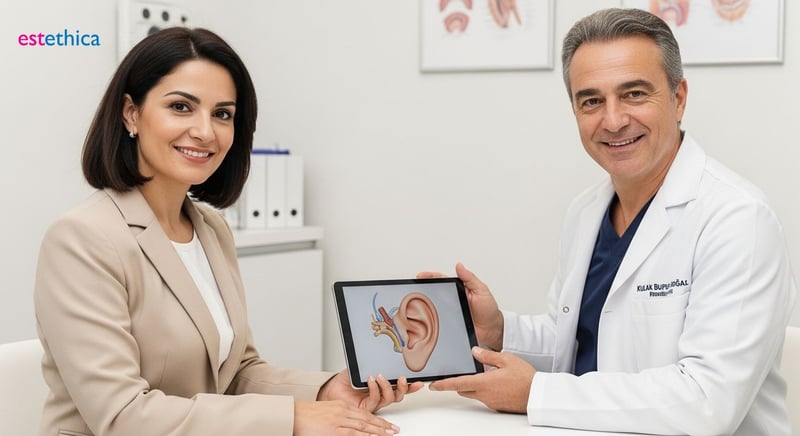Otoplasty: Your Guide to Ear Surgery for Perfect Proportions
Otoplasty, or ear surgery, reshapes prominent or misshapen ears to improve facial balance and self-confidence. This guide covers what ear pinning surgery entails, who is a good candidate, the recovery process, and how to choose a qualified specialist for ear reshaping.
Understanding Otoplasty: What is Ear Pinning Surgery?
What is Otoplasty?
Otoplasty, commonly known as ear pinning surgery, is a sophisticated surgical procedure designed to address ears that are disproportionately large or protrude significantly from the head. Performed by experienced plastic surgeons, this intervention aims to reposition the ears closer to the scalp or reduce their size, thereby enhancing overall facial harmony. This form of cosmetic ear surgery is a highly sought-after procedure for both children and adults who experience distress or self-consciousness about their ear aesthetics. It’s crucial to understand that the primary goal of otoplasty is not to alter auditory function but to improve facial symmetry and bolster an individual's confidence. The specific techniques employed in ear reshaping vary based on the patient's unique concerns; however, they typically involve carefully sculpting the ear's cartilage and, in some cases, securing it in its new position using sutures.
Who is a Candidate for Ear Surgery?
The ideal candidates for this type of ear surgery are individuals who are dissatisfied with the appearance of their ears, particularly if they stand out too prominently. For younger patients, it is generally advised to postpone the procedure until they reach the age of five or six, allowing their ear cartilage to mature sufficiently. Adults contemplating ear surgery should maintain good overall health and possess realistic expectations regarding the potential results. Common concerns addressed by ear pinning surgery include ears that are perceived as too large, ears that stick out too far, or noticeable asymmetry between the two ears. A thorough consultation is an indispensable step in evaluating a candidate's suitability and discussing their personal aesthetic aspirations. While otoplasty focuses on enhancing facial features, individuals pursuing comprehensive body contouring might also explore options like the Tummy Tuck Transformation: Reveal Your Ideal Silhouette, showcasing the diverse range of transformative procedures available.
The effectiveness of cosmetic ear surgery lies in its ability to provide a lasting solution to ear prominence. Patients often report a significant boost in self-esteem following the procedure, feeling more comfortable in social situations and less preoccupied with their ear appearance. The recovery process, while requiring some care, is generally manageable, with most individuals returning to normal activities within a few weeks. This cosmetic ear surgery is a testament to how subtle adjustments can lead to profound improvements in self-perception and overall well-being.

Cosmetic Ear Surgery: Reshaping Your Ears for Natural Aesthetics
The Art of Ear Reshaping
Cosmetic ear surgery, commonly known as otoplasty, is a procedure dedicated to achieving a natural and balanced appearance for the ears. The primary goal is to enhance your overall profile by ensuring your ears are in harmonious proportion with your facial features. This form of ear surgery can address a variety of concerns, including ears that lack natural folds, those with overly large ear conchas, or ears that protrude excessively. Surgeons employ meticulous techniques to sculpt and carefully position the ear's cartilage, ensuring the final results appear subtle and seamlessly integrated with the rest of your face. Ultimately, the aim is to provide a lasting solution to any insecurities stemming from the appearance of one's ears, offering a significant boost in self-confidence.
For those interested in a comprehensive overview of the transformative potential of these procedures, exploring resources like Sculpt Your Confidence: The Ultimate Guide to Ear Reshaping can offer deeper insights into the process and its benefits. Understanding the nuances of ear reshaping is crucial for anyone considering this surgical path.
Surgical Techniques in Otoplasty
A variety of surgical techniques are utilized in ear reshaping procedures to achieve optimal and personalized outcomes. The specific approach is always tailored to an individual's unique ear anatomy and their desired aesthetic goals. Some of the most common methods involve strategically placing sutures to fold and secure the cartilage into a more desirable position, or in some cases, removing a small amount of excess cartilage. New folds can also be created to achieve a more natural appearance. Incisions for these procedures are typically made discreetly behind the ear, which ensures they are virtually invisible once the healing process is complete. This intricate nature of the procedure underscores the importance of selecting a highly experienced plastic surgeon. Their expertise is paramount in achieving satisfactory and natural-looking results from your cosmetic ear surgery. Whether addressing prominent ears through ear pinning surgery or refining other aspects of ear aesthetics, the surgeon's skill is key. A successful outcome from ear pinning surgery relies on both the patient's expectations and the surgeon's technical proficiency. The field of cosmetic ear surgery offers a powerful way to correct ear-related concerns.
Otoplasty Recovery: What to Expect After Ear Reshaping
The Recovery Journey
Embarking on the journey of otoplasty, or ear reshaping, signifies a commitment to enhanced facial harmony and self-confidence. Following your otoplasty procedure, a dedicated recovery period is paramount for optimal healing and achieving the desired aesthetic outcomes. Immediately after surgery, you will typically be fitted with a supportive compression bandage or headband. This is a crucial step designed to protect the ears, minimize swelling, and provide gentle support as the tissues begin to heal. While some discomfort is to be expected, it is generally well-managed with the pain medication prescribed by your surgeon. During this initial phase, it's vital to be mindful of your sleeping position, avoiding sleeping on your side to prevent undue pressure on the surgical sites. Protecting your ears from any accidental bumps or trauma is also a key consideration.
Expect a degree of swelling and bruising around the ears in the days following the procedure. This is a normal part of the healing process and will gradually subside. Most patients find that they can return to their usual light daily activities within about a week. However, it is essential to refrain from strenuous exercise and activities that could potentially jar or strain the ears for several weeks, as advised by your surgeon. Understanding the timeline and what to expect can greatly ease any concerns during this period. For those considering other cosmetic enhancements, information on Body Contouring, Fat Reduction & Skin Tightening Today might be of interest as you explore various aesthetic improvements.
Post-Operative Care and Timeline
Diligent post-operative care is absolutely vital for ensuring the success of your ear reshaping. This includes meticulously keeping the surgical sites clean, attending all scheduled follow-up appointments with your surgeon, and strictly adhering to all post-operative instructions provided. While the initial external bandages are typically removed within the first week, your surgeon may recommend continuing to wear a soft, supportive headband. This is particularly important during sleep for several weeks to maintain the corrected ear position and further aid healing. As the swelling diminishes completely, the final results of the otoplasty will become increasingly apparent, revealing a noticeable improvement in the appearance of your ears.
This transformation often leads to a significant boost in self-esteem and a greater sense of confidence in one's appearance. It's important to remain vigilant and report any signs of infection, such as increased redness, warmth, or pus, or any unusual or severe pain to your surgeon immediately. Prompt communication ensures that any potential issues are addressed swiftly. The success of this otoplasty procedure is a testament to both surgical skill and dedicated patient care.

Choosing an Ear Surgery Specialist for Optimal Results
Selecting the Right Surgeon
Undertaking an otoplasty procedure is a significant decision, and the cornerstone of achieving successful and aesthetically pleasing outcomes lies in selecting a highly qualified and experienced plastic surgeon. It is paramount to seek out surgeons who are board-certified in plastic surgery or facial plastic surgery, and more importantly, those who possess a specialized focus and a demonstrable track record in performing ear reshaping procedures. Don't hesitate to thoroughly review their portfolio of before-and-after photographs to gauge the quality and consistency of their work. Patient testimonials can also offer valuable insights into others' experiences. Scheduling consultations with multiple surgeons is a wise approach, allowing you to openly discuss your personal goals, any concerns you may have, and understand their proposed approach to your ear surgery. A truly competent surgeon will not only listen attentively to your needs but also explain the intricacies of the procedure with clarity, manage your expectations realistically, and address all your queries with confidence.
Consultation and Planning for Your Ear Surgery
The initial consultation for what is commonly referred to as ear pinning surgery is a critical phase. During this appointment, the surgeon will conduct a comprehensive examination of your ears, assessing their structure and symmetry. Equally important is a thorough review of your medical history to ensure your suitability for the procedure. This is your prime opportunity to pose all pertinent questions regarding the surgical techniques that will be employed, the potential risks and complications associated with cosmetic ear surgery, the expected recovery process, and any associated costs. It is essential that you feel completely comfortable and confident with the chosen surgeon and their entire medical team. A meticulously planned procedure, cultivated through open and honest communication and a clear, shared understanding of every step involved, is absolutely key to achieving satisfying and successful results from your cosmetic ear surgery. Remember, while aesthetic procedures like ear surgery are a primary focus, overall well-being is also crucial; for information on related topics, you might find details on Vaginal Rejuvenation: Enhancing Confidence with Labiaplasty & Tightening informative for a broader perspective on confidence-enhancing procedures.
Choosing the right professional for your ear surgery is more than just a procedural step; it's an investment in your confidence and overall satisfaction. The nuances of otoplasty require a surgeon with an artistic eye and precise surgical skills. Therefore, diligent research and a thoughtful selection process are indispensable for optimal results from your ear pinning surgery.

Otoplasty: Advanced Techniques for Ear Reshaping and Prominent Ear Correction
Otoplasty, commonly known as ear pinning surgery, utilizes sophisticated surgical procedures to address ears that are disproportionately large or protrude significantly from the head. This intervention aims to reposition the ears closer to the scalp or reduce their size, enhancing overall facial harmony through precise cartilage reshaping.
The expertise in cosmetic ear surgery lies in its ability to provide a lasting solution to ear prominence, focusing on achieving a natural and balanced appearance. A variety of surgical techniques are employed in ear reshaping procedures to ensure optimal and personalized outcomes for each patient.
Experienced plastic surgeons perform this intervention, offering a transformative solution for individuals seeking to enhance their facial aesthetics. This form of cosmetic ear surgery is a highly sought-after procedure for both children and adults who experience distress or self-consciousness about their ear aesthetics, demonstrating a deep understanding of patient needs and desired outcomes.
Your Otoplasty Recovery Journey: Expert Care for Optimal Ear Surgery Results
The recovery journey following ear reshaping is carefully managed to ensure optimal results and patient comfort. Expect a degree of swelling and bruising around the ears in the days following the procedure, which is a normal part of the healing process.
Diligent post-operative care is absolutely vital for ensuring the success of your ear reshaping, with clear guidelines provided for a smooth transition back to daily activities. Surgeons provide detailed instructions on wound care and activity restrictions to promote effective healing and minimize any potential complications.
The initial consultation for what is commonly referred to as ear pinning surgery is a critical phase, allowing for open discussion about goals, expectations, and the surgical plan. This collaborative approach ensures that patients feel informed and confident throughout the entire process.
Understanding why ear surgery is performed, who is a suitable candidate, and the typical recovery process are key components of patient education, fostering trust and transparency. This detailed guidance helps individuals feel well-prepared and assured as they undergo this transformative procedure.